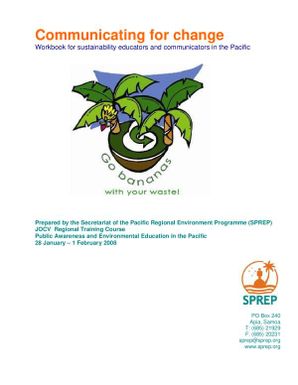Communicating for change : Workbook for sustainbility educators and communicators in the Pacific
- Description:
- In the Pacific, land and sea are life; livelihoods and the natural environment are inseparable. Culture, tradition and livelihoods, are underpinned by the incredible biodiversity of the nearly 3,000 islands and atolls of the Pacific. However, high birth rates, unsustainable use of natural resources, increasing dependency on the cash economy, labour migration, and the deterioration of traditional social systems, are changing traditional lifestyles. Globally, the Pacific is considered a unique region in the world, from both marine and terrestrial perspectives. However, the Pacific is also one of the most threatened with more extinctions per capita than anywhere else in the world. Less than 30% of the forest cover remains in a natural state and what is left is being removed at up to 4% per annum on some islands. The threat of extinctions will continue as more coastal areas are degraded by increased land based sources of pollution, the modification of critical habitats, the increasingly unsustainable exploitation of resources, and the impacts of climate change.
- Display date:
- 2008
- Collections:
- Secretariat of the Pacific Regional Environment Programme (SPREP)
- Publisher:
- Secretariat of the Pacific Regional Environment Programme (SPREP)
- Content partner:
- Secretariat of the Pacific Regional Environment Programme (SPREP)
- Availability:
- Not specified
-
Copyright status: All rights reservedFind out more about what you are able to do with this itemThis item is all rights reserved, with means you'll have to get permission from Secretariat of the Pacific Regional Environment Programme (SPREP) before using it. For more information, please see our use and reuse page.What can I do with this item?Non-infringing useNZ copyright law does not prevent every use of a copyright work, and this item may be hosted by an international institute or organisation. You should consider what you can and cannot do with a copyright work.No sharingYou may not copy and/or share this item with others without further permission. This includes posting it on your blog, using it in a presentation, or any other public use.No modifyingYou are not allowed to adapt or remix this item into any other works.No commercial useYou may not use this item commercially.
Related items
Welcome and warm Pasifik greetings
The information on this site has been gathered from our content partners.
The names, terms, and labels that we present on the site may contain images or voices of deceased persons and may also reflect the bias, norms, and perspective of the period of time in which they were created. We accept that these may not be appropriate today.
If you have any concerns or questions about an item, please contact us.
